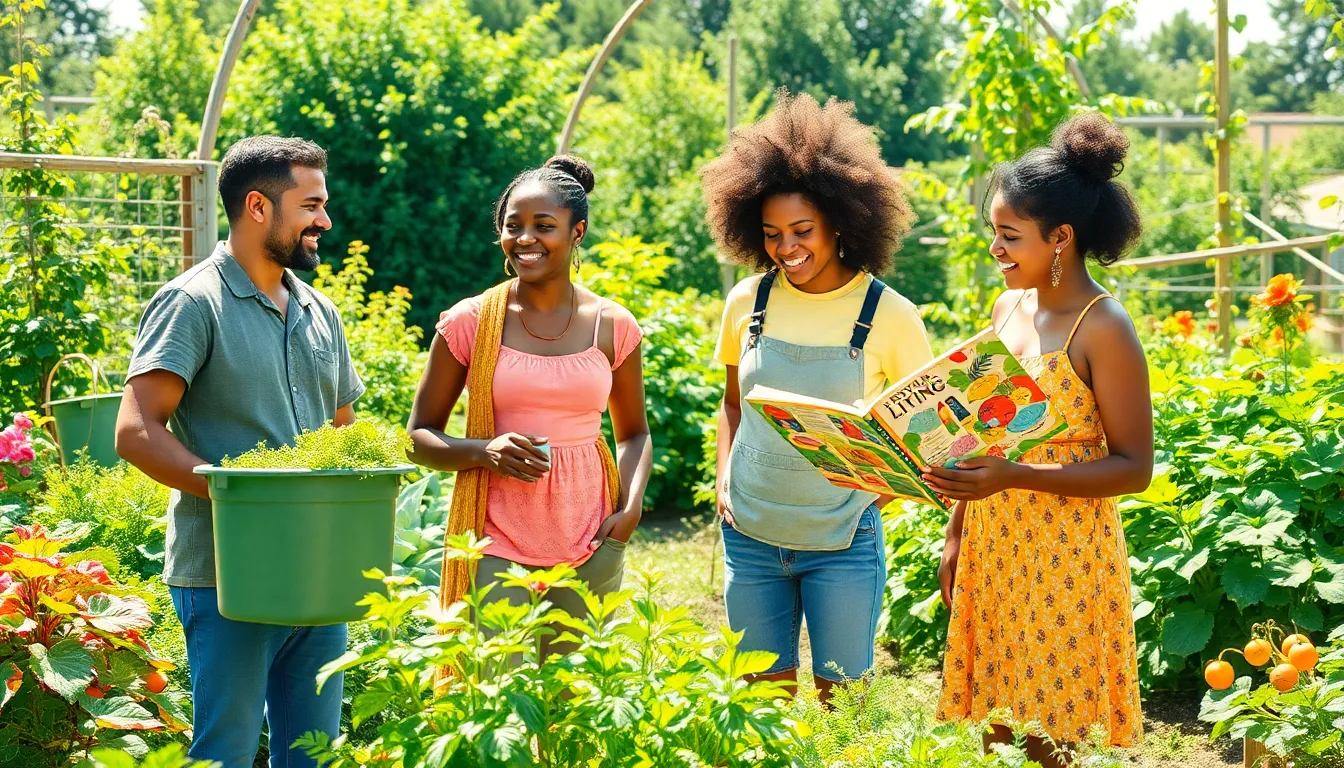In a world where plastic seems to outnumber people and climate change is the hot topic at every dinner party, sustainable living has never been more important—or more confusing. Enter the world of sustainable living books, where eco-warriors and curious minds alike can find guidance on how to save the planet without sacrificing comfort. These books are like a treasure map, leading readers to greener pastures and a more conscious lifestyle.
Whether it’s learning how to grow your own veggies or discovering the magic of upcycling, these pages are packed with tips that make saving the Earth feel less like a chore and more like a fun adventure. So grab a cup of organic tea, kick back, and prepare to dive into the delightful world of sustainable living literature. Who knew saving the planet could be this entertaining?
Table of Contents
ToggleWhat Are Sustainable Living Books?
Sustainable living books serve as essential guides for individuals committed to an eco-friendly lifestyle. These books cover diverse topics, from zero waste strategies to renewable energy practices. Readers find practical advice on minimizing waste, conserving resources, and cultivating a sustainable mindset.
A variety of authors contribute to this genre. Some share personal experiences, while others include expert insights or scientific research. By blending storytelling with factual knowledge, these books engage readers and inspire action.
Many sustainable living books provide step-by-step instructions for projects like composting or creating eco-friendly cleaning supplies. Readers can implement these strategies easily and make meaningful changes in their daily routines. Additionally, they often feature captivating illustrations that enhance the learning experience.
Some popular sustainable living books include “Zero Waste Home” by Bea Johnson and “The Upcycle” by William McDonough and Michael Braungart. Each offers unique perspectives on achieving sustainability while maintaining comfort. Suggestions for readers also include focusing on ethical consumerism and supporting local businesses.
Ultimately, choosing from a range of sustainable living books equips readers with the knowledge needed to contribute positively to the environment. Exploring these resources fosters creativity in adopting green practices. Many individuals discover that sustainable living can be both enjoyable and rewarding, sparking greater interest in environmental stewardship.
Benefits of Reading Sustainable Living Books

Reading sustainable living books offers profound benefits, supporting individuals in fostering a greener lifestyle. Engaging with these resources cultivates a deeper connection to environmental issues and eco-friendly practices.
Enhanced Environmental Awareness
Enhanced environmental awareness develops as readers explore diverse topics. Sustainable living books illuminate the impact of personal choices on the planet, urging individuals to reflect on their actions. Understanding concepts like carbon footprints becomes achievable through relatable examples. Awareness of biodiversity, resource depletion, and climate change is crucial. Each book empowers readers by providing valuable knowledge that encourages activism. Readers often find inspiration to voice their concerns and participate in sustainability initiatives.
Practical Lifestyle Changes
Practical lifestyle changes emerge from the actionable insights found in sustainable living books. Readers encounter a variety of strategies for implementing eco-friendly habits in everyday life. Emphasizing simplicity, many books guide individuals on managing waste, conserving water, and choosing sustainable products. Step-by-step projects, like gardening or upcycling, allow for hands-on engagement that enhances learning. Making small, manageable changes leads to significant environmental benefits over time. By integrating these practices, readers contribute positively to their communities while enjoying a healthier lifestyle.
Top Sustainable Living Books to Consider
Sustainable living books offer practical knowledge for creating an eco-friendly lifestyle. They provide guidance on various aspects of living sustainably, from waste management to energy conservation.
Classic Titles
“Zero Waste Home” by Bea Johnson stands out as a pioneering work in the movement toward reducing waste. It details actionable steps for minimizing household waste and embraces a minimalist lifestyle. Another influential title, “The Upcycle” by William McDonough and Michael Braungart, inspires readers to rethink consumption habits through innovative design. These classics emphasize that sustainability doesn’t require sacrificing comfort and can improve overall quality of life.
Recent Releases
“Plastic Free” by Beth Terry presents a modern approach to eliminating plastic usage in daily life. It includes practical tips for replacing common items with sustainable alternatives. “The Sustainable(ish) Living Guide” by Jen Gale focuses on simplifying eco-friendly living. This title offers accessible steps for readers to incorporate green practices without feeling overwhelmed. Both recent releases make sustainable living relatable and achievable for a broader audience.
How to Choose the Right Sustainable Living Book for You
Selecting the ideal sustainable living book involves considering personal interests and specific goals. Identify core topics that resonate, such as zero waste, gardening, or renewable energy. Look for engaging narratives and practical tips that align with those interests.
Prioritize books with actionable advice. Readers benefit from titles that break down concepts into manageable steps. Seeking books with illustrations can enhance understanding, making projects like composting or DIY cleaning supplies more accessible.
Evaluate the author’s background and expertise. Many authors blend personal experiences with scientific research, providing credibility and relatability. Noting authors like Bea Johnson and Beth Terry can guide readers toward well-regarded resources.
Consider the book’s format and structure. Some readers prefer a narrative style, while others appreciate a straightforward, instructional approach. Assessing a book’s layout helps in determining if it meets individual learning preferences.
Review recommendations and ratings for additional insights. Online platforms often showcase reviews that highlight the strengths and weaknesses of various titles. Engaging with community feedback offers valuable perspectives before making a selection.
Explore a diverse range of books. From classic titles like “The Upcycle” to recent releases such as “The Sustainable(ish) Living Guide,” variety supports different interests and lifestyles. Embracing diversity ensures a broader understanding of sustainable practices.
Choosing the right book supports a successful transition toward a greener lifestyle. Each reader’s journey is unique, and the right resource can inspire and motivate sustainable change.
Exploring sustainable living books opens up a world of possibilities for those committed to making eco-friendly choices. These resources not only provide practical advice but also inspire creativity and innovation in everyday life. By engaging with diverse authors and their unique perspectives, readers can discover effective strategies tailored to their lifestyles.
As individuals embark on their journey toward sustainability, the right book can serve as a guiding light. The actionable insights and relatable content found in these titles empower readers to make meaningful changes. Ultimately, embracing sustainable living is not just a personal choice; it’s a collective movement toward a healthier planet for future generations.






